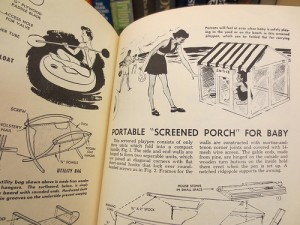
Adam Davidson, of NPR’s “Planet Money,” makes a sheepish confession right at the very start of his latest NYTimes piece: “raising a child in Park Slope, Brooklyn, can bear an embarrassing resemblance to the TV show ‘Portlandia.'” Having trucked his family down to the Brooklyn Baby Expo, Davidson saw everything from plant-resin teething rings to organic-cotton car seat covers (to limit babies’ exposure to manmade fibers). He realized, the baby market is a commodity market, and that’s when he started to feel better:
It’s easy to feel like a sucker once you realize that nearly every dollar you’ve paid over the commodity price is probably wasted. But the process also has enormous benefits for all consumers.
When companies need to compete, they must differentiate, and in the baby market that can mean safety innovations that set the newest standard—possibly inspiring the government to raise safety regulations. Even if you’re not an early adopter of BPA-free bottles, you may soon find that your store brand bottles are BPA-free, just like joovy® “boob baby bottle.” And then everyone’s a little safer, even if that concern is relatively new.
Davidson turns to classic research from sociologist Viviana Zelizer to expand on “The Sippy Cup 1%” and changing childhood:
It might shock the shoppers at Brooklyn Baby Expo, but the idea that everything children touch should be completely safe is a fairly new one. In previous generations—and for most people currently living in poorer countries—having children was an economic investment. Viviana Zelizer, a Princeton sociologist, in her 1985 classic, “Pricing the Priceless Child,” tracked how childhood in America was transformed between the 1880s and the 1930s. During this period, Zelizer says, parents stopped seeing their children as economic actors who were expected to contribute to household finances. Families used to routinely take out life insurance plans on their children to make up for lost wages in the not unlikely event of a child’s death.
But eventually, increased societal wealth, child-labor laws and the significant drop in child mortality led parents to reclassify their children, Zelizer explained, as “a separate sphere, untainted by economic concerns.” This came along with “an increasingly sentimentalized view of children,” in which their comfort and protection can be given no price. Now, for the first time in human history, having a child in the United States is a net financial cost for a parent. This, of course, has been a huge boon to child-product manufacturers. Companies profit from our sentiment with extraneous features. The whole process is prone to produce absurdities like the $4,495 Roddler custom stroller, but the best advances become inexpensively incorporated into everybody’s products. In the end, it really does contribute to making children safer than ever.

Comments 5
Friday Roundup: July 12, 2013 » The Editors' Desk — July 12, 2013
[...] “Economics, Sentimentality, and the Safe Baby,” by Letta Page. An economist walks into a baby expo… and calls on some classic social science. [...]
nancy — July 14, 2013
Hi, Letta. Thanks for sharing useful info.
Kyle — August 15, 2013
Good article. I absolutely appreciate this website.
Thanks!
Friday Roundup: Awards Edition! » The Editors' Desk — December 20, 2013
[…] “The Sippy Cup 1%,” by Adam Davidson, NYTimes Magazine. (See also our “Economics, Sentimentality, and the Safe Baby.”) […]
Wendy — October 14, 2014
Hi, Letta.
I have not hear this before. So interesting and useful.